- Table of Content
- 1.Statement conc...
- 2.Moderate flare...
- 3.Closer to the ...
- 4.Review of sola...
- 5.Review of geom...
- 6.Noticeable Sol...
- 7.PROBA2 Observa...
- 8.The Internatio...
- 9.Geomagnetic Ob...
- 10.The SIDC Space...
- 11.Review of iono...
- 12.Action!
2. Moderate flare in tiny sunspot group
3. Closer to the SUN than you have ever been!
4. Review of solar activity
5. Review of geomagnetic activity
6. Noticeable Solar Events (28 Feb 2022 - 6 Mar 2022)
7. PROBA2 Observations (28 Feb 2022 - 6 Mar 2022)
8. The International Sunspot Number by Silso
9. Geomagnetic Observations in Belgium (28 Feb 2022 - 6 Mar 2022)
10. The SIDC Space Weather Briefing
11. Review of ionospheric activity (28 Feb 2022 - 6 Mar 2022)
12. Action!
Statement concerning Ukraine
Please visit our website: https://www.stce.be/content/statement-concerning-ukraine
Moderate flare in tiny sunspot group
An interesting solar eruption was observed by numerous solar satellites on 2 March. The M2 flare peaked at 17:39UTC in the small sunspot region NOAA 2958. Statistically, this kind of sunspot groups has only a few percent chance to produce an M-class flare (see the STCE's SWx classification page at https://www.stce.be/educational/classification ), but to everybody's surprize and against all odds, NOAA 2958 managed to produce just such a moderate event. The imagery underneath is from SDO/HMI (https://sdo.gsfc.nasa.gov/data/aiahmi/ ) and compares the region in white light (left) with a magnetogram of the same area (right - white are areas where the magnetic field lines are leaving the Sun ("positive"), black is where they are returning to the Sun, i.e. "negative"). The overlaid grid denotes 5 degrees by 5 degrees per square. Clips are available in the online version of this article at https://www.stce.be/news/576/welcome.html
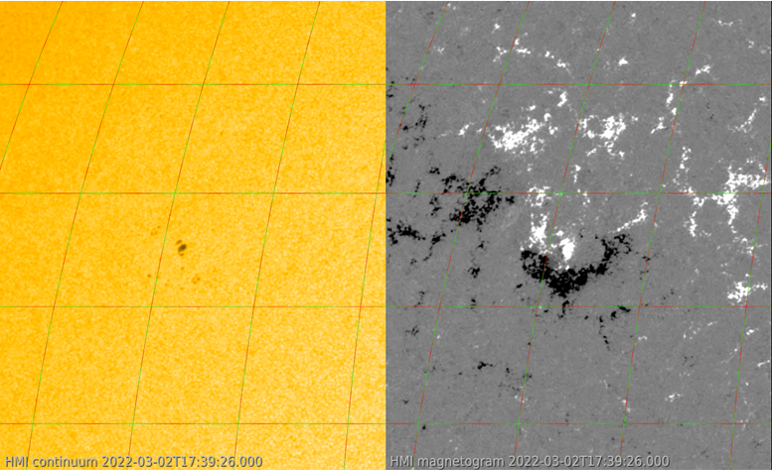
Note the string of very small sunspots south of and close to the main spot. These "Tiny Tims" have a magnetic polarity which is opposite to that of the main, slightly bigger sunspot (i.e. resp. black and white). Due to the close proximity of the opposite polarity spots, the slightest instability may give rise to a solar flare. Now, this kind of magnetic configurations is known for its potential to produce strong solar flares. Back in 2014, NOAA 2158 had a very similar configuration and was also larger than NOAA 2958. Also here, the X1.6 flare came as a big surprize (see this STCE news item at https://www.stce.be/news/268/welcome.html for more info). The compilation underneath compares the flare in extreme ultraviolet (EUV; SDO/AIA 171 - left) with a magnetogram (right) about 40 minutes after the flare's peak in soft x-rays, to better show the series of post-eruption coronal loops. This "arcade" is located mostly over the eastern portion ("left") of the magnetic inversion line of the region, i.e. the "border" between the opposite magnetic polarities.
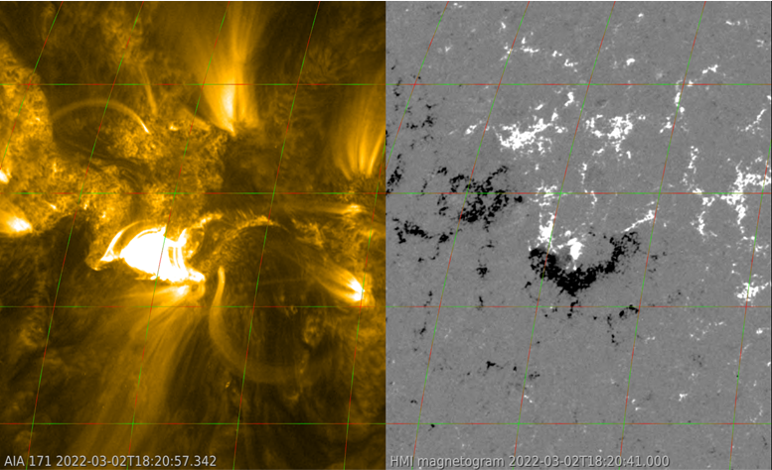
For STEREO-A (https://stereo-ssc.nascom.nasa.gov/beacon/beacon_secchi.shtml ), trailing the Earth by about 34 degrees, the event happened near its central meridian (north-south line on the solar disk) and so it had a really good view on the eruption. EUV images showed that the flare was accompanied by coronal dimming (a temporary darkening in the solar corona, also known as "transient coronal hole") and an obvious coronal wave (see this STCE news item at https://www.stce.be/news/241/welcome.html for more info). These are all indicative of an associated coronal mass ejection, but coronagraphic images indicated this CME had no earth-directed component.
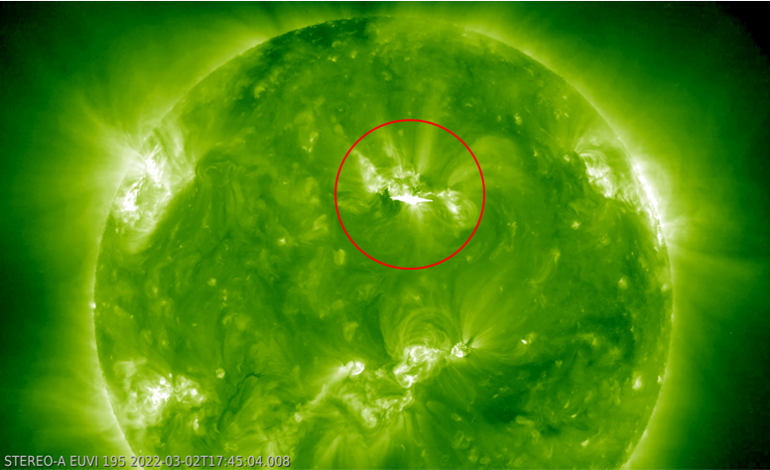
Also instruments on board Solar Orbiter captured the event. Solo's High Resolution Imager (HRI) provided some great pictures of the coronal loops in EUV (HRI 171). The resolution of the images is already excellent, and will further improve as it is heading for its first close encounter with the Sun on 26 March. More info on Solar Orbiter and its trajectory are in this ESA news item at https://www.esa.int/Science_Exploration/Space_Science/Solar_Orbiter/Solar_Orbiter_crosses_the_Earth-Sun_line_as_it_heads_for_the_Sun .
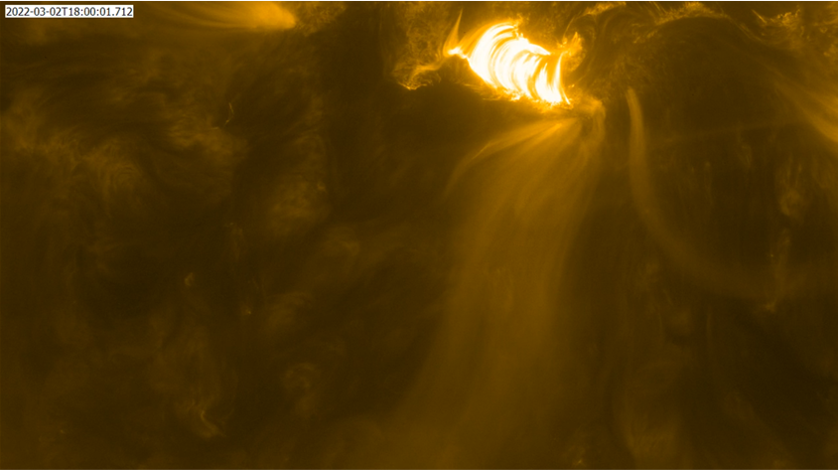
Credits movie: the SolO/EUI team (https://wwwbis.sidc.be/EUI/intro ).
Closer to the SUN than you have ever been!
SUN installation at the AfricaMuseum April 05 - 24, 2022. Tickets and info: https://www.africamuseum.be/nl/see_do/temporary_exhibition/sun
Marvel at the beauty of our closest star with this lifelike representation of the sun. A 3D projection with state-of-the-art images form the SDO/AIA telescope on a gigantic, hanging 6 meter diameter balloon shows 10 weeks of the life of our Sun. Smoke and sound effects mimic the Sun's outer atmosphere to complete the unique experience. This light artwork brings you closer to the sun than you have ever been before!
SUN is an installation by British artist Alex Rinsler and solar expert Prof. Robert Walsh (University of Central Lancashire). With this installation in the AfricaMuseum, in cooperation with the STCE, the spectacular artwork is shown outside the United Kingdom for the very first time.
The sun is the determining factor for life and climate on this globe. Through human activity, climate change is one of the most pressing issues faced by society today. This exhibit in the Small Rotunda of the AfricaMuseum also presents world-leading research on the Sun and Earth's climate carried out at both scientific institutions.
.jpg)
Review of solar activity
Solar flaring activity was low, except on Mar 2 when it was moderate. Nine Active Regions (AR) appeared on disk, numbered by NOAA as 2954-2962. NOAA AR 2958 produced an M2 flare on 2 Mar 17:39 UT, while NOAA AR 2954, 2959, and 2962 emitted numerous C-class flares throughout the week.
No Earth-directed Coronal Mass Ejections (CME) were detected by the available coronagraphs.
The greater than 10 MeV proton flux was at nominal levels for the whole week.
The greater than 2 MeV electron flux remained below the 1000 pfu alert threshold up until 6 Mar 12:00 UT, peaked at 3000 pfu at 6 Mar 18:00 UT and remained above the threshold for the final few hours of the week.
The 24h electron fluence was at nominal levels throughout the week.
Review of geomagnetic activity
At the start of the week, Earth was under the influence of a High Speed Stream (HSS) with speeds up to 550 km/s. The solar wind (SW) then gradually decreased and reflected a slow SW regime until 3 Mar 17:00 UT when a sector boundary crossing was detected at L1. It caused the SW speed to increase to 500 km/s and as the SW begun to drop on 4 Mar, it was followed by a HSS that arrived on 5 Mar. The HSS appearance caused the SW speed to return to the 550 km/s mark and remained at that level until the end of the week. The total magnetic field reached a maximum value of 14 nT, on 5 Mar. The Bz fluctuated between -13 nT and 10 nT during this period. The solar wind conditions remained under the influence of the HSS for the rest of the week.
The geomagnetic conditions were at moderate to quiet levels from the start of the week until 5 Mar when they reached minor storm levels. The last day of the week, 6 Mar, the returned to moderate levels.
Noticeable Solar Events (28 Feb 2022 - 6 Mar 2022)
| DAY | BEGIN | MAX | END | LOC | XRAY | OP | 10CM | TYPE | Cat | NOAA |
| 02 | 1731 | 1739 | 1747 | N15E29 | M2.0 | 1B | II/3 | 46 | 2958 |
| LOC: approximate heliographic location | TYPE: radio burst type |
| XRAY: X-ray flare class | Cat: Catania sunspot group number |
| OP: optical flare class | NOAA: NOAA active region number |
| 10CM: peak 10 cm radio flux |
PROBA2 Observations (28 Feb 2022 - 6 Mar 2022)
Solar Activity
Solar flare activity fluctuated from very low to moderate during the week.
In order to view the activity of this week in more detail, we suggest to go to the following website from which all the daily (normal and difference) movies can be accessed: https://proba2.oma.be/ssa
This page also lists the recorded flaring events.
A weekly overview movie can be found here (SWAP week 623): https://proba2.sidc.be/swap/data/mpg/movies/weekly_movies/weekly_movie_2022_02_28.mp4
Details about some of this week's events can be found further below.
If any of the linked movies are unavailable they can be found in the P2SC movie repository here:
https://proba2.oma.be/swap/data/mpg/movies/
Wednesday Mar 02
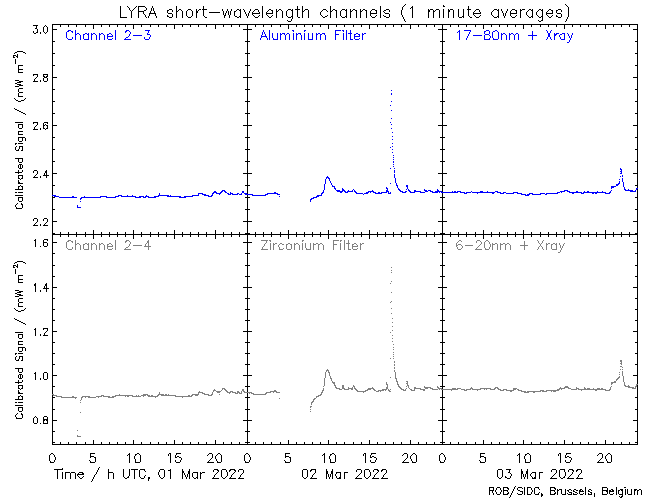
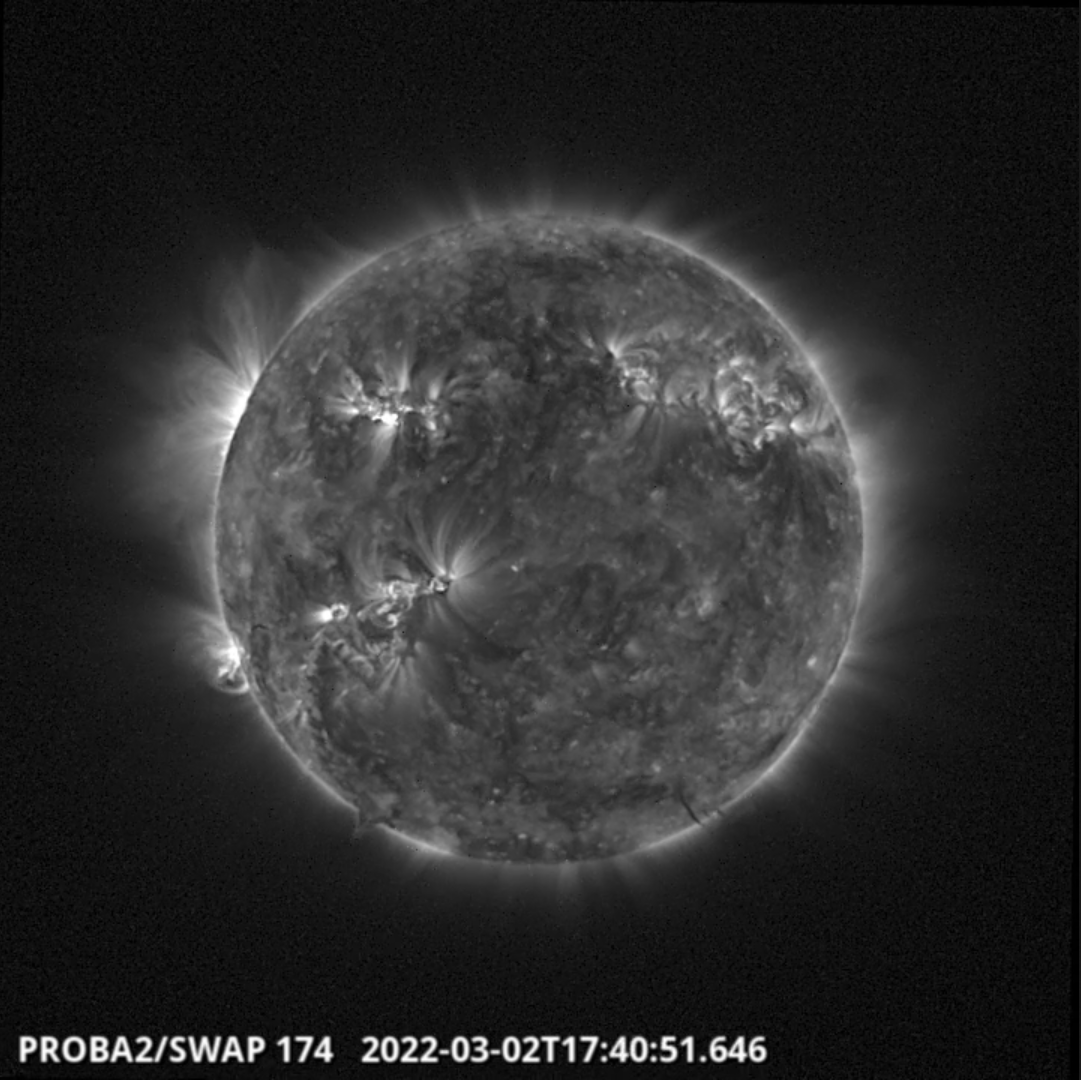
The largest flare of the week, an M2.0 flare, was observed by SWAP and LYRA. The flare is visible in the north-west quadrant on 2022-Mar-02, as shown in the SWAP image above taken at 17:40 UT.
Find a movie of the event here (SWAP movie): https://proba2.sidc.be/swap/movies/20220302_swap_movie.mp4
The International Sunspot Number by Silso
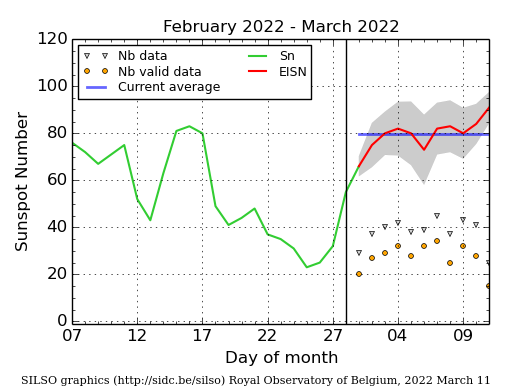
The daily Estimated International Sunspot Number (EISN, red curve with shaded error) derived by a simplified method from real-time data from the worldwide SILSO network. It extends the official Sunspot Number from the full processing of the preceding month (green line), a few days more than one solar rotation. The horizontal blue line shows the current monthly average. The yellow dots give the number of stations that provided valid data. Valid data are used to calculate the EISN. The triangle gives the number of stations providing data. When a triangle and a yellow dot coincide, it means that all the data is used to calculate the EISN of that day.
Geomagnetic Observations in Belgium (28 Feb 2022 - 6 Mar 2022)
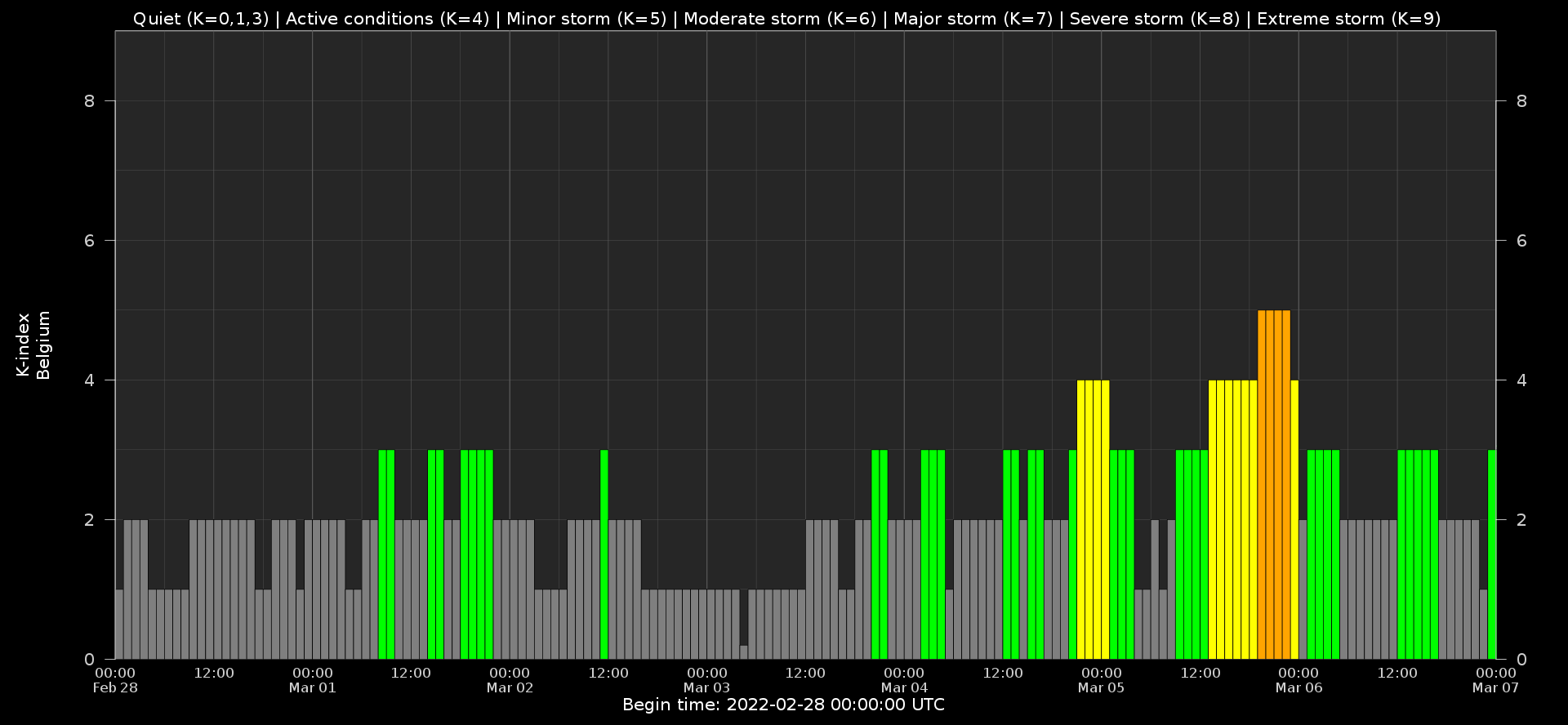
Local K-type magnetic activity index for Belgium based on data from Dourbes (DOU) and Manhay (MAB). Comparing the data from both measurement stations allows to reliably remove outliers from the magnetic data. At the same time the operational service availability is improved: whenever data from one observatory is not available, the single-station index obtained from the other can be used as a fallback system.
Both the two-station index and the single station indices are available here: http://ionosphere.meteo.be/geomagnetism/K_BEL/
The SIDC Space Weather Briefing
The Space Weather Briefing presented by the forecaster on duty from 28 Feb to 6 Mar. It reflects in images and graphs what is written in the Solar and Geomagnetic Activity report: https://www.stce.be/briefings/20220307_SWbriefing.pdf
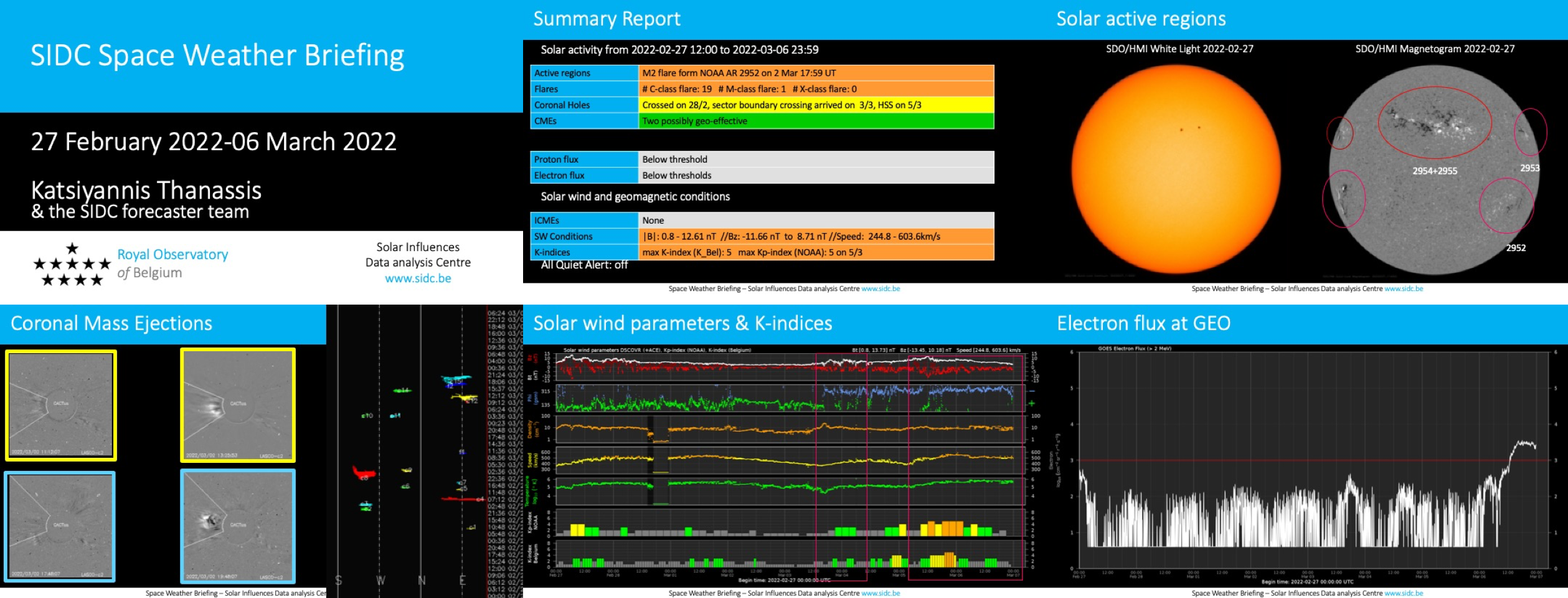
If you need to access the movies, contact us: stce_coordination at stce.be
Review of ionospheric activity (28 Feb 2022 - 6 Mar 2022)
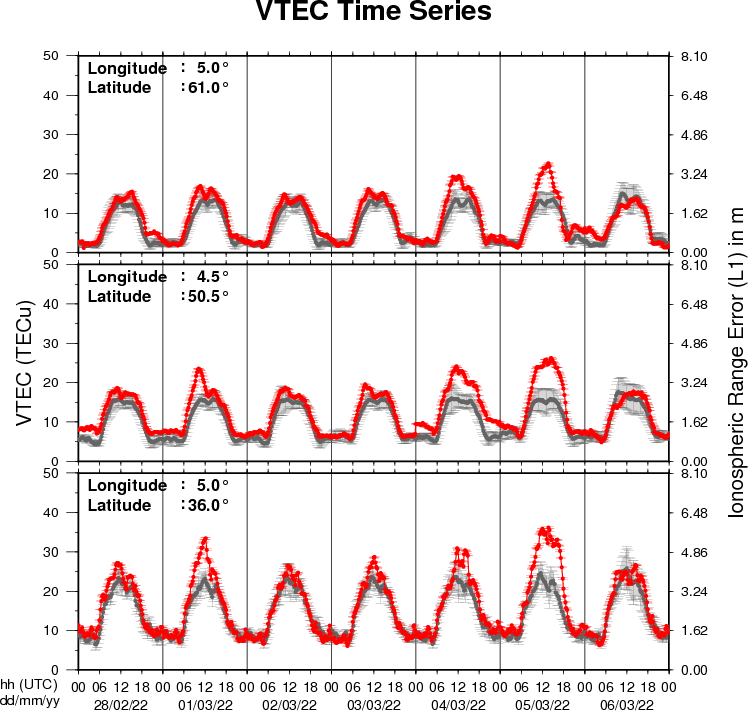
The figure shows the time evolution of the Vertical Total Electron Content (VTEC) (in red) during the last week at three locations:
a) in the northern part of Europe(N 61deg E 5deg)
b) above Brussels(N 50.5deg, E 4.5 deg)
c) in the southern part of Europe(N 36 deg, E 5deg)
This figure also shows (in grey) the normal ionospheric behaviour expected based on the median VTEC from the 15 previous days.
The VTEC is expressed in TECu (with TECu=10^16 electrons per square meter) and is directly related to the signal propagation delay due to the ionosphere (in figure: delay on GPS L1 frequency).
The Sun's radiation ionizes the Earth's upper atmosphere, the ionosphere, located from about 60km to 1000km above the Earth's surface.The ionization process in the ionosphere produces ions and free electrons. These electrons perturb the propagation of the GNSS (Global Navigation Satellite System) signals by inducing a so-called ionospheric delay.
See http://stce.be/newsletter/GNSS_final.pdf for some more explanations ; for detailed information, see http://gnss.be/ionosphere_tutorial.php
Action!
Check out our activity calendar: activities and encounters with the Sun-Space-Earth system and Space Weather as the main theme. We provide occasions to get submerged in our world through educational, informative and instructive activities.
If you want your event in our calendar, contact us: stce_coordination at stce.be
* March 14-16, onsite (!) Space Weather Introductory Course by SWEC, Space Weather Education Center - fully booked
* March 22, Wetenschapsbattle in Ghent, Belgium
* March 25-26, Space Days in Leuven, Belgium
* April 5-17, SUN exhibit at the AfricaMuseum, Tervuren, belgium
* April 26, Public Lecture on the Solar Corona in EUV (Dutch), Urania, Hove, Belgium
* April 27-29, STCE at the Symposium on Space Educational Activities, Barcelona, Spain
* April 28, Public Lecture on SolO/EUI, Astropolis, Oostende, Belgium
* July 3, Public Lecture on ROB's mission to the Sun, Cosmodrome, Genk, Belgium
* August 25, Public Lecture on Space Weather and Aviation, Astropolis, Oostende, Belgium
* October 24-28, 18th European Space Weather Week, Zagreb, Croatia
Check: https://www.stce.be/calendar
